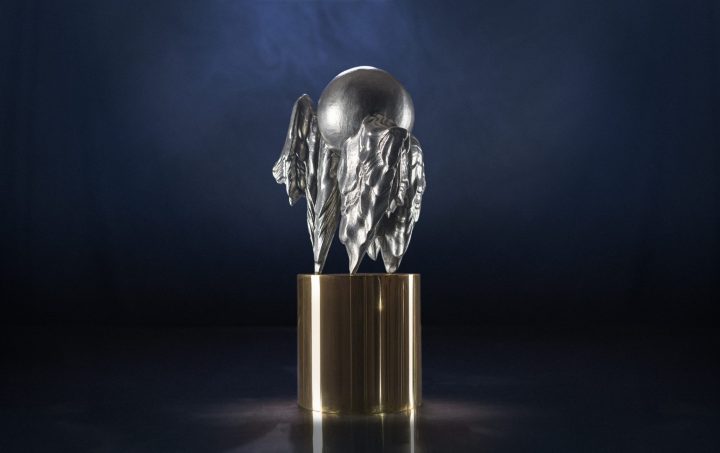The Right Livelihood Award, widely known as the ‘Alternative Nobel Prize’, celebrates its 40th anniversary this year. Tony Cragg, one of the world’s foremost sculptors, has custom-designed the new Award. The sculpture is made from Humanium Metal by IM, a unique material made of recycled metal from gun destruction programs in Central America. Climate activist Greta Thunberg is among the first Laureates to receive the new Award Sculpture.
“Every day, around 1.000 people are killed by guns in non-conflict areas around the globe. The Right Livelihood Award was founded to honor and support people who solve global problems. Creating the Award Sculpture from melted, illegal guns is a perfect match, says Ole von Uexkull, executive director of the Right Livelihood Foundation.
Gun violence is a global epidemic. To tackle this problem, the organization IM Swedish Development Partner launched the Humanium Metal initiative in 2016, which aims to decrease gun violence and build inclusive and peaceful societies. So far, about 5,500 illegal weapons have been recycled within the project. The most recent destruction of guns took place yesterday in El Salvador. The metal from seized firearms is melted and molded into units, called Humanium Metal, which are then made available for commercial production. The revenues go back to communities affected by gun violence. Products available on the market include watches and jewellery.
Humanium Metal is sometimes referred to as “the most valuable metal in the world” as the destruction of guns contributes to removing weapons from the streets and saving lives. Soon, the first Right Livelihood Awards made from Humanium Metal will be given to climate activists Greta Thunberg from Sweden and nonviolent activist Aminatou Haidar from Western Sahara, among others.
“The Right Livelihood Award is one of the world’s most prestigious awards in sustainability, peace and social justice. We are thrilled and proud that the awards are now being created out of Humanium Metal. I hope that this will inspire to more sustainable collaborations between business, governments and civil society working for a more peaceful world”, says Martin Nihlgård, Secretary-General at IM Swedish Development Partner.
Famous British sculptor Tony Cragg created the awards pro bono. Cragg is known for working with unconventional materials, such as Kevlar and industrial scraps, and can now add yet another unusual material to his list made of illegal guns. “It is a delight for me to participate in this context”, says Tony Cragg.
Laureates will receive their prizes at the 2019 Right Livelihood Award Presentation in Stockholm on 4 December. For the first time, the public is invited to participate in the Award Presentation as the Award celebrates its 40th anniversary. Edward Snowden, who received the Right Livelihood Award in 2014, will join the celebration via link from Moscow and the artists José González and Ane Brun will perform at the event.
Tickets for the Award Presentation are available via Cirkus.se.
About the Right Livelihood Award
Established in 1980, the Right Livelihood Award honours and supports courageous people solving global problems. To date, there are 178 Laureates from 70 countries.
The Swedish Right Livelihood Foundation presenting the Award sees its role as being the megaphone and shield for the Laureates and provides them with long-term support. It seeks to help protect those Award recipients whose life and liberty are in danger. The Foundation has Special Consultative Status with the UN Economic and Social Council.
Anyone can propose candidates to be considered for the Right Livelihood Award. The Laureates are selected by an international Jury after careful investigation by the Foundation’s research team. Unlike most other international prizes, the Right Livelihood Award has no categories. It recognises that, in striving to meet the challenges of today’s world, the most inspiring and remarkable work often defies any standard classification.
How it all began – The Nobel Foundation rejected an environmental prize
In 1979, the Swedish-German philanthropist and stamp collector Jakob von Uexkull turned to the Nobel Foundation with the proposal to create two new Nobel Prizes, one environmental award and one award to promote knowledge and perspectives of people in poor countries. To fund the prizes, he offered to sell his stamp collection, worth more than one million US Dollars, and donate the money to the Nobel Foundation.
Jakob was alarmed by the disconnect between the urgency of global problems and the way the international community was dealing with them. He saw how decision-makers were meeting behind closed doors, out of touch with reality. Activists and civil society organizations were at the same time gathering outside the meeting rooms, often presenting constructive solutions to the problems. But their proposals were not taken seriously, and Jakob wanted to do something about it.
“Whoever gets the Nobel Prize will be listened to”, he thought and contacted the Nobel Foundation, which politely rejected the proposal to establish two new awards. There and then, Jakob decided to create the Right Livelihood Award to support people fighting for a just, peaceful and sustainable world. He went ahead and sold parts of the stamp collection, and that was how it all began. The Right Livelihood Award received a lot of attention when it was presented for the first time in 1980, one day before the Nobel Prize. Today, it is one of the most prestigious awards in sustainability, social justice and peace.
Income from the sale of stamps generated sufficient means to kick off the prize, but ever since the Right Livelihood Award has been receiving its funding from private donors. A unique feature is that the Award comes with long-term support that includes networking and protection for Laureates under threat. Because of its founding history, it has come to be known as the ‘Alternative Nobel Prize’.










